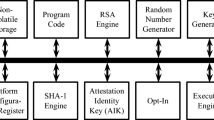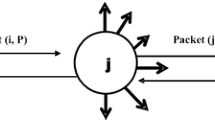Abstract
Cryptography and authentication are traditional approach for providing network security. However, they are not sufficient for solving the problems which malicious nodes compromise whole wireless sensor network leading to invalid data transmission and wasting resource by using vicious behaviors. This paper puts forward an extended hierarchical trusted architecture for wireless sensor network, and establishes trusted congregations by three-tier framework. The method combines statistics, economics with encrypt mechanism for developing two trusted models which evaluate cluster head nodes and common sensor nodes respectively. The models form logical trusted-link from command node to common sensor nodes and guarantees the network can run in secure and reliable circumstance.
Similar content being viewed by others
References
Giordano S.Handbook of Wireless Networks and Mobile Computing [M]. Hoboken: John Wiley and Sons, 2002.
Levente B, Jean P H. Report on a Working Session on Security in Wireless Ad Hoc Networks[J].ACM Mobile Computing and Communications Review. 2003,7(1):74–94.
Amir P A, Datta A, McDonald C. Evolutionary Computation [J].CEC2004, 2004,2:1938–1943.
Tanachaiwiwat S, Dave P, Bhindwale R,et al. Performance Computing, and Communications [C] //IEEE International Conference on 2004. New York: IEEE Press, 2004:463–469.
Gupta G, Younis M. Performance Evaluation of Load-Balanced Clustering of Wireless Sensor Networks [C]//IEEE International conference on communications (ICC 2003). Anchorage. Alaska, May, 2003,33:6–381.
Marti S, Giuli T, Lai K,et al. Mitigating Routing Misbehavior in Mobile Ad-Hoc Networks [C]//The 6th ACM International Conference on Mobile Computing and Networking. New York: ACM Press, 2000:255–265.
Karlof C, Wagner D. Secure Routing in Wireless Sensor Networks: Attacks and Countermeasures [C].First IEEE International Workshop on Sensor Network Protocols and Applications. New York: IEEE Press, 2003:113–127.
Chen J, Luo H Q. Faults Detection and Correction of Nodes' Data in Wireless Sensor Network [J].Journal of Chengdu University of Information Technology, 2004,19(4):309–312 (Ch).
Karlof C, Li Y P, Polastre J.ARRIVE: Algorithm for Robust Routing in Volatile Environments [R]. Berkeley: Computer Science Division University of California Berkeley, May, 2002.
Parkes D C.Iterative Combinatorial Auctions: Achieving Economic and Computational Efficiency [D]. Philadelphia: Department of Computer and Information Science, University of Pennsylvania, May 2001.
Author information
Authors and Affiliations
Corresponding author
Additional information
Foundation item: Supported by the National Natural Science Foundation of China (60373087, 60473023, 90104005)
Biography: DU Ruiying (1964-), female, Associate professor, research direction: wirless sensor network.
Rights and permissions
About this article
Cite this article
Ruiying, D., Mingdi, X. & Huanguo, Z. An extended hierarchical trusted model for wireless sensor networks. Wuhan Univ. J. Nat. Sci. 11, 1489–1492 (2006). https://doi.org/10.1007/BF02831804
Received:
Issue Date:
DOI: https://doi.org/10.1007/BF02831804




